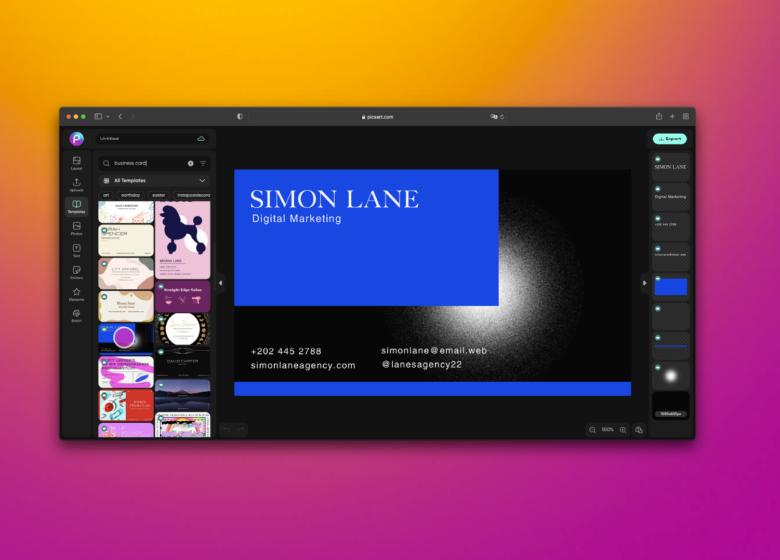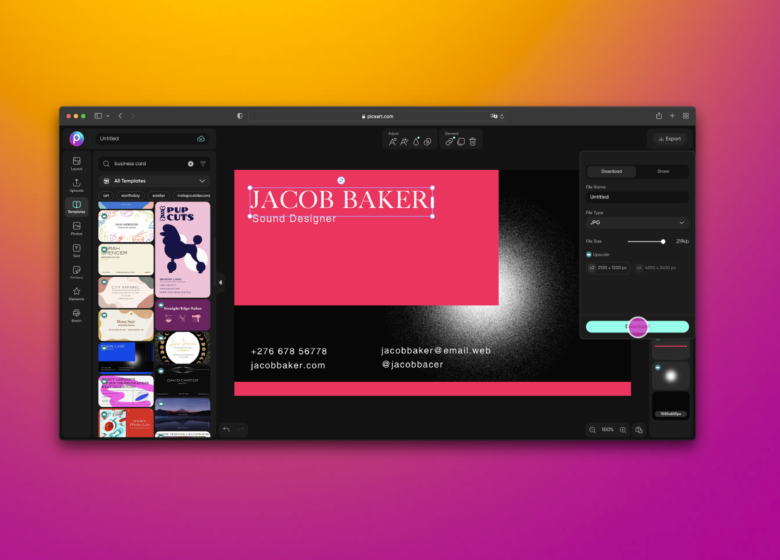Technology has transformed business communication and professional interactions. Yet the more things change, the more they stay the same. If you represent a brand, business, or service, you should consider carrying a business card. It’s the quickest and most effective way to introduce yourself to someone, conveying important personal contact information such as name, title, email, website, address, and phone number. They’re also a strong way to make a positive first impression. But design will play a big part in that. So let’s talk business card designs.
In this article, we’ll cover the standard U.S. business card size and the principles of business card design, so that you’ll know how to use the little space you have effectively. After that we’ll show you how to make your own business cards easily using Picsart. We’ll also go over some successful examples of business card designs, so that you can have something in mind when you start making your own.
What Is the Standard U.S. Business Card Dimension?
The standard U.S. business card size is 3.5 x 2 inches, around the size of the average credit card (which they’ll likely end up next to in someone’s wallet). But it’s important to bear in mind that when you’re designing a card to be printed, there are other factors to consider. The first is the bleed.
‘Bleed’ is a printing term, used to describe the design elements that touch or extend beyond the edge of the page. To account for it in the printing process, printers use what’s called a bleed area, in which the designer will usually provide an extra eighth of an inch outside of the edge of the page to account for errors that may occur in the printing process. After trimming, the bleed ensures that everything looks good, and there are no unprinted edges.

Another important factor to consider when creating a business card is the margin, which designates a safe zone for your design. It’s usually set usually a quarter or an eighth of an inch within the borders on all sides. It exists to ensure the important elements of your designs don’t get cut off when the business card is printed out.
When you take the bleed area into account, the dimensions you should be using when you’re setting up your project are 3.75 x 2.25 inches. If you’re designing in the Picsart app, you’ll be setting your dimensions in pixels, at 300 pixels per inch – a good default setting if you intend to send something to print. The dimensions you’ll use (including the bleed area) are 1125 x 675 px.
The Dos and Don’ts of Business Card Design
Not all business cards are created equal. What makes for good business card designs will depend on a lot of factors, but here are some basic dos and don’ts.
Do…
Display your Company Logo and Brand Prominently
Business cards have come to take on a life of their own in the modern era. But it’s still important not to forget that they’re primarily functional. The entire point of a business card is to establish a line of communication between you and a contact, so making sure your information is legible and easy to find is rule number one. Business card templates can help with this, but you can also design from scratch.
Know your Recipient
The fonts, color, texture, and paper stock used conveys everything about your brand. This should align with the industry you’re operating in too. For example, if you’re a builder, it might not be necessary to showcase fancy typography. However, if you’re a graphic designer, savvy font pairings and artistic flair are a must.
Aim for Originality
While not overwhelming your new business connection with text and information is important, that doesn’t mean your business card should be boring. Try to imbue it with some personality. That might mean a fun font or a unique shape. This’ll help your card stand out amongst others.
Play with Textures
The beauty of business cards is that, unlike most business communications nowadays, they come in a physical form. As you design, consider the type of paper that you’ll use and how your designs will pair. There are many specialized printing techniques, each of which conveys certain qualities. Embossing, which is the process of creating raised or recessed reliefs in paper, can make your cards look authoritative. Using matted paper, which has a smooth, waxy coating, can help give a more modernist look. You can also be resourceful with materials. Consider a business card made out of recycled materials, for instance – especially if that aligns with your brand or service.

Don’t…
Clutter Cards with Too Much Information
Business cards are small, so they clutter easily. Try not to overdo it with the contact info. Keep it to the bare necessities. And don’t forget, your card is double-sided. Be efficient with that space.
Give in to Gimmicks
It may be tempting to use the business card as a way to showcase your wit and creativity. But that can be a hit or a miss. It can even come off as unprofessional. A good rule of thumb with business cards is: when in doubt, choose the simplest route.
Deviate from your Brand’s Aesthetic
Your business card should reflect your brand. Having a business card that looks totally different from your website or your stationery makes it harder for customers, clients, and colleagues to recognize your brand.
5 Examples of Business Cards That Work
Here are five examples of business cards that employ many of the principles we’ve discussed in this post, to help get your creative juices flowing and inspire you to make your own. Bear in mind, these are not necessarily common business cards, but ones that really pop. It’s up to you how simple or creative you want to get.
How To Design a Business Card Using Picsart
Ready to apply your knowledge of business card designs and turn it to your advantage? Picsart can help make that as easy as possible for you. You can design from scratch following the steps below or you can start with a Picsart business card template. If you’re feeling adventurous, here’s how to do it from scratch.
On the Web
1. Open the Picsart web editor and choose Custom Size, input 1125 x 675 into the dimensions, and click on Create Design.

2. From the left-hand panel, click on the Templates tool.

3. Search for business card templates and select the one you like best. Remember, you can customize any element.

4. That includes editing the existing text, color, sizes, adding, deleting, or replacing elements. Just click on the part you want to change and experiment with the corresponding tools to make your adjustments.

5. When you’re done with the customization, click on Export and download your work.

On the App
If you’re on the Picsart app, follow these easy instructions:
1. Open the app and tap the purple plus icon at the bottom of the screen to start a new project.
2. Scroll to the Color Backgrounds section and select one you like.
3. Select the Tools icon and click on the Crop tool.

4. Make sure the Free Crop icon is selected. Then, at the top of the screen, tap on the dimensions. Doing so will conjure up a pop-up that allows you to type in your Custom Crop Ratio. Reminder: For a U.S. standard business card size, the dimensions are 1125 x 675 px with bleed.
5. Next, tap on the Text icon at the bottom of your screen. Type in your contact information. Select the font you’d like to use.
6. Tap on the checkmark at the top right and place the text anywhere on your image. Lastly, if you have a logo to add, scroll to the right on the bottom menu and tap on the Add Photo icon.

7. When you’re satisfied with your edits, save or post your image. 
Create at the Speed of Culture
Picsart is a full ecosystem of free-to-use content, powerful tools, and creator inspiration. With a billion downloads and more than 150 million monthly active creators, Picsart is the world’s largest creative platform. Picsart has collaborated with major artists and brands like BLACKPINK, Taylor Swift, the Jonas Brothers, Lizzo, Ariana Grande, Jennifer Lopez, One Direction, Sanrio: Hello Kitty, Warner Bros. Entertainment, iHeartMedia, Condé Nast, and more. Download the app or start editing on web today to enhance your photos and videos with thousands of quick and easy editing tools, trendy filters, fun stickers, and brilliant backgrounds. Unleash your creativity and upgrade to Gold for premium perks!









